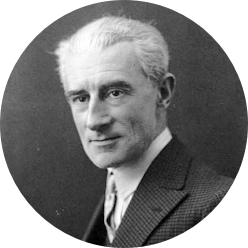
Морис Равель
7 марта 1875 г. - Сибур (Франция) — 28 декабря 1937 г. - Париж (Франция)
About
Морис Равель, от Болеро до Томбо для Куперена
Равель, самый увлекательный музыкант 20-го века, международно известный благодаря своему Болеро, был одарённым ребёнком. Тем не менее, его обучение в Консерватории не было увенчано знаменитой Римской премией, которую он пытался получить трижды. С другой стороны, его встречи с Габриэлем Форе и Жедальжем оказались важными и решающими для его музыкальной ориентации. Его дружба с пианистом Рикардо Виньесом привела его к написанию первых произведений для инструмента, Павана для умершей принцессы и Игры воды (Jeux d’eau), чья фортепианная запись была одновременно роскошной и смелой. Отстранённый от официальных сфер, Равель занимался исключительно композицией и создавал шедевры один за другим: Сказки природы, Демоны ночи и Испанская рапсодия.